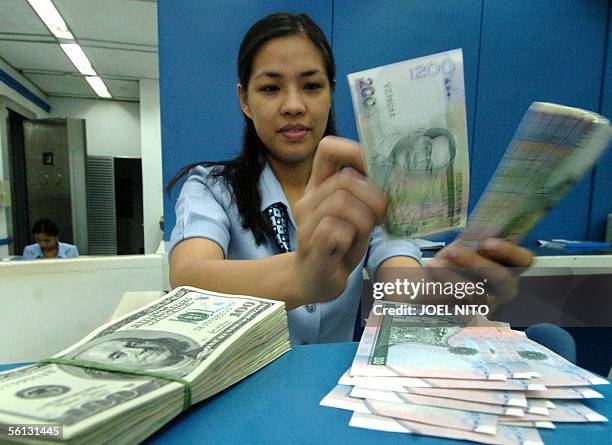Understanding the Exchange Rate: U.S. Dollar to Philippine Peso

currencies is an essential indicator for businesses, investors, and individuals engaged in trade, tourism, and remittances. Understanding the dynamics of this exchange rate involves a deep dive into the factors affecting it, the historical context, and its implications for both economies.
Historical Context
The relationship between the U.S. dollar and the Philippine peso dates back to the early 20th century, following the Philippine-American War. The establishment of the Philippine Commonwealth in 1935 marked a significant change in the currency system. The Philippine peso was pegged to the U.S. dollar at a rate of 2:1. This fixed exchange rate system lasted until the 1970s, when the Philippines faced economic challenges, leading to a floating exchange rate system.
Since the early 1980s, the Philippine peso has experienced significant fluctuations against the U.S. dollar. Various factors, including economic crises, changes in government policies, and external shocks, have influenced the exchange rate. Understanding these historical trends is crucial for comprehending the current dynamics of the USD-PHP exchange rate.
Current Exchange Rate Dynamics
As of October 2024, the exchange rate between the U.S. dollar and the Philippine peso fluctuates regularly due to various factors, including economic indicators, geopolitical events, and market sentiment. The exchange rate is a reflection of the relative strength of the two economies and can be influenced by:
- Economic Indicators:
- Inflation Rates: Higher inflation in the Philippines compared to the U.S. may weaken the peso as purchasing power declines.
- Interest Rates: The Bangko Sentral ng Pilipinas (BSP) and the Federal Reserve’s monetary policy decisions impact exchange rates. Higher interest rates in the U.S. often strengthen the dollar as investors seek higher returns.
- Gross Domestic Product (GDP): Economic growth rates affect investor confidence. A robust Philippine economy may strengthen the peso against the dollar.
- Political Stability: Political events, such as elections or changes in government policy, can lead to volatility in the currency market. Political instability in the Philippines may lead to a weaker peso as investors seek safety in the U.S. dollar.
- Global Economic Conditions: Events such as the COVID-19 pandemic and geopolitical tensions can impact global trade and investment flows, affecting the demand for both currencies. A global economic downturn may lead to a stronger dollar as investors seek safe-haven assets.
- Remittances: The Philippines is one of the largest recipients of remittances in the world. Overseas Filipino Workers (OFWs) send money back home, and fluctuations in the USD-PHP exchange rate can significantly impact the value of these remittances for families relying on this income.
The Role of the U.S. Dollar
The U.S. dollar is considered the world’s primary reserve currency. Its stability and acceptance in global trade mean that fluctuations in the dollar’s value have far-reaching effects on economies worldwide, including the Philippines. The dollar is often seen as a safe haven during times of economic uncertainty, leading to increased demand when global markets are volatile.
In the Philippines, the dollar serves various functions:
- Trade: Many international transactions are conducted in U.S. dollars, making it essential for Filipino exporters and importers.
- Remittances: A significant portion of remittances from OFWs is sent in U.S. dollars, affecting the exchange rate when converted to pesos.
- Investments: The Philippine stock market and other investment vehicles often have dollar-denominated assets, making the USD-PHP exchange rate a critical factor for investors.
The Role of the Philippine Peso
The Philippine peso, while less recognized globally than the dollar, plays a vital role in the country’s economy. It reflects the economic health of the Philippines and is influenced by local market conditions, government policies, and external factors.
- Local Transactions: The peso is used for daily transactions in the Philippines. A stable peso is essential for consumer confidence and economic stability.
- Tourism: The tourism sector in the Philippines is significantly impacted by the exchange rate. A strong peso may deter foreign tourists, while a weaker peso can make the Philippines a more attractive destination.
- Foreign Investments: The strength of the peso can influence foreign direct investment (FDI). Investors may be hesitant to invest in a country with a depreciating currency due to perceived risks.
The Impact of Exchange Rate Fluctuations
Exchange rate fluctuations can have significant implications for various sectors in the Philippines:
- Inflation: A weaker peso can lead to higher import costs, contributing to inflation. As prices rise, consumers may face a decreased standard of living.
- Exports and Imports: A depreciated peso can benefit exporters by making Philippine goods cheaper for foreign buyers. However, it also raises the cost of imports, affecting businesses reliant on foreign goods and services.
- Debt Servicing: Many countries, including the Philippines, have foreign-denominated debts. A weaker peso increases the burden of servicing these debts, impacting the national budget.
Strategies for Managing Exchange Rate Risk
To mitigate the impact of exchange rate fluctuations, businesses and individuals can adopt several strategies:
- Hedging: Companies can use financial instruments such as options and forwards to protect themselves against adverse currency movements.
- Diversification: Investors can diversify their portfolios to include assets in different currencies, reducing exposure to fluctuations in the USD-PHP exchange rate.
- Monitoring Economic Indicators: Keeping an eye on economic indicators, interest rates, and geopolitical events can help individuals and businesses make informed decisions regarding currency conversion and investment.
The Future of the USD-PHP Exchange Rate
Predicting the future of the USD-PHP exchange rate involves analyzing various factors that may influence both economies. Several trends and potential developments to consider include:
- Global Economic Recovery: As the world continues to recover from the pandemic, shifts in global economic conditions may affect the strength of the U.S. dollar and the Philippine peso.
- Monetary Policy Changes: Changes in monetary policy by the Federal Reserve and the Bangko Sentral ng Pilipinas will play a critical role in shaping the exchange rate.
- Technological Advancements: Innovations in finance, such as cryptocurrencies and digital currencies, may impact traditional currency dynamics, including the USD-PHP exchange rate.
Conclusion
The exchange rate between the U.S. dollar and the Philippine peso is a complex interplay of various factors. Understanding this relationship is crucial for businesses, investors, and individuals who engage in trade, investment, or travel between the two countries. While historical trends provide valuable insights, ongoing economic developments will continue to shape the dynamics of the USD-PHP exchange rate. As we move forward, keeping abreast of economic indicators, global events, and domestic policies will be essential for navigating the ever-changing landscape of currency exchange.





